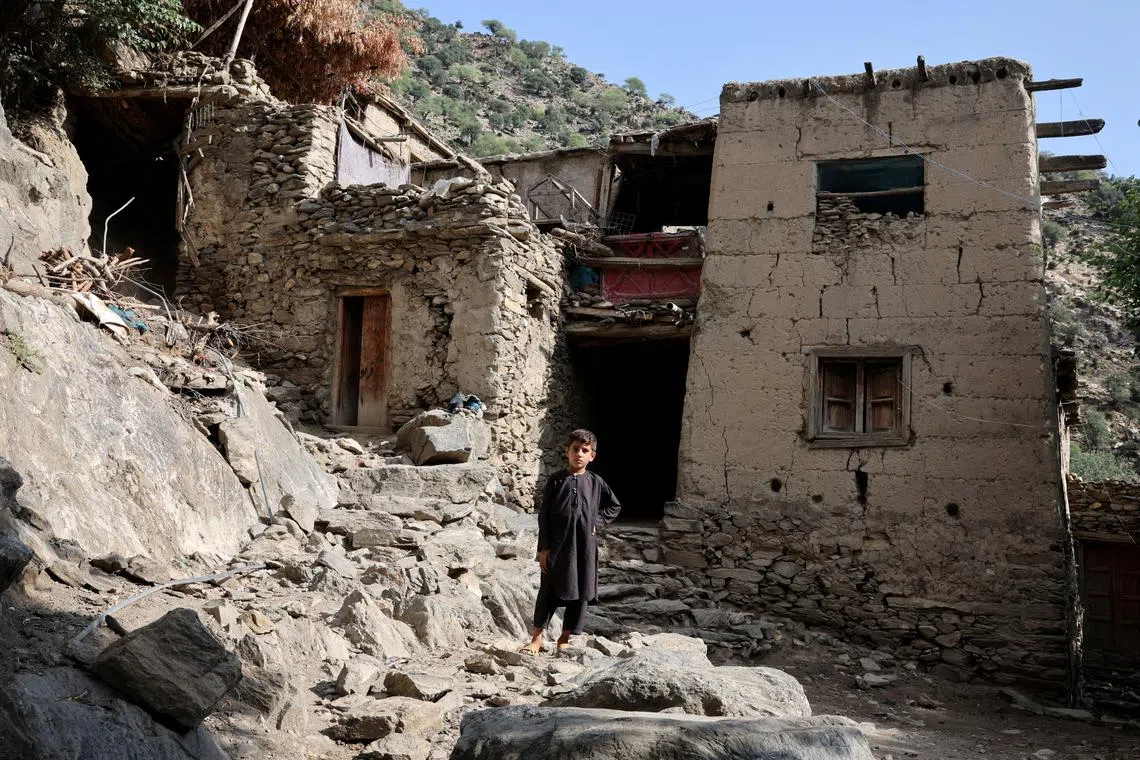Two powerful aftershocks pummel Afghanistan after earthquakes kill 2,200
Sign up now: Get insights on Asia's fast-moving developments

The Taliban administration estimated 2,205 deaths and 3,640 injuries as at Sept 4.
PHOTO: REUTERS
Follow topic:
JALALABAD, Afghanistan - Two powerful aftershocks struck eastern Afghanistan 12 hours apart, triggering fears of more deaths and destruction on Sept 5 as rescuers battled mountainous terrain and harsh weather.
The latest aftershocks follow two earthquakes that ravaged a nation crushed by war, poverty and shrinking aid.
The Taliban administration estimated 2,205 deaths and 3,640 injuries as at Sept 4.
Survivors in the earthquake-prone region are scrambling for basic amenities as the United Nations and other agencies warn of a critical need for funds, food, medical supplies and shelter, with the World Health Organisation (WHO) seeking funds of US$4 million (S$5.14 million).
Ambulances ferried to hospital 13 people injured after a tremor of 6.2 magnitude on the night of Sept 4 in Nangarhar province, with its epicentre in the district of Shiwa near the Pakistan border, said regional health spokesman Naqibullah Rahimi.
Ten were discharged after treatment and three were in stable condition, he added.
A Reuters witness said details of the damage were still being collected after continuous aftershocks in Nangarhar, with its capital Jalalabad about 150km from Kabul.
The German Research Centre for Geosciences (GFZ) said Sept 5’s earthquake of magnitude 5.4 struck the south-east at a depth of 10km, just hours after Sept 4’s event.
With houses built mostly of dry masonry, stone, and timber, some families preferred to stay in the open to guard against shocks, rather than return home.
Residents of the Nurgal district of Kunar have left their homes to live in tents, on the surrounding high land near a river, or in the open, for fear of more tremors.
Fallen rocks and earth blocked access to some badly affected villages, holding up rescue and relief efforts, they said.
The week’s first earthquake of 6 magnitude, just minutes before midnight on Aug 31, was one of Afghanistan’s deadliest, unleashing damage and destruction in Nangarhar and Kunar provinces when it struck at a depth of 10km.
A second quake of 5.5 magnitude on Sept 2 caused panic and interrupted rescue efforts as it sent rocks sliding down mountains and cut off roads to villages in remote areas.
The two initial quakes flattened villages in both provinces, destroying more than 6,700 homes, and rescue workers pulled bodies from the rubble on Sept 4.
Afghanistan’s earthquakes mainly happen in the Hindu Kush mountain range, where the Indian and Eurasian tectonic plates meet.
Funding crisis
Landslides and debris on key roads hampered relief work, the WHO said, as it called for more funds to provide healthcare and disease surveillance.
“A funding gap of at least US$4 million threatens to delay critical activities, underscoring the urgent need for international support,” it added in a statement.
It warned of the risk of disease, stemming from overcrowded shelters, unsafe water and inappropriate waste management, while an influx of Afghans recently deported from Pakistan and Iran strains the fragile healthcare system.
Afghanistan’s Taliban government made an urgent appeal for international aid
But relief has been scant in a country largely ignored by the world since the Taliban takeover in 2021 that is struggling to accommodate the millions of deported Afghans, as well drought victims in its north.
The UN, which has said money to help quake victims will run out soon, plans to launch an emergency appeal for funds, a senior official in the country said.
It has released US$10 million, more than the trickle of cash announced by rich nations, though some have sent assistance such as tents.
“We have some seed funding, but we are looking to make a flash appeal,” Ms Kate Carey, deputy head of the UN’s humanitarian affairs coordination office for Afghanistan, told Reuters. REUTERS

